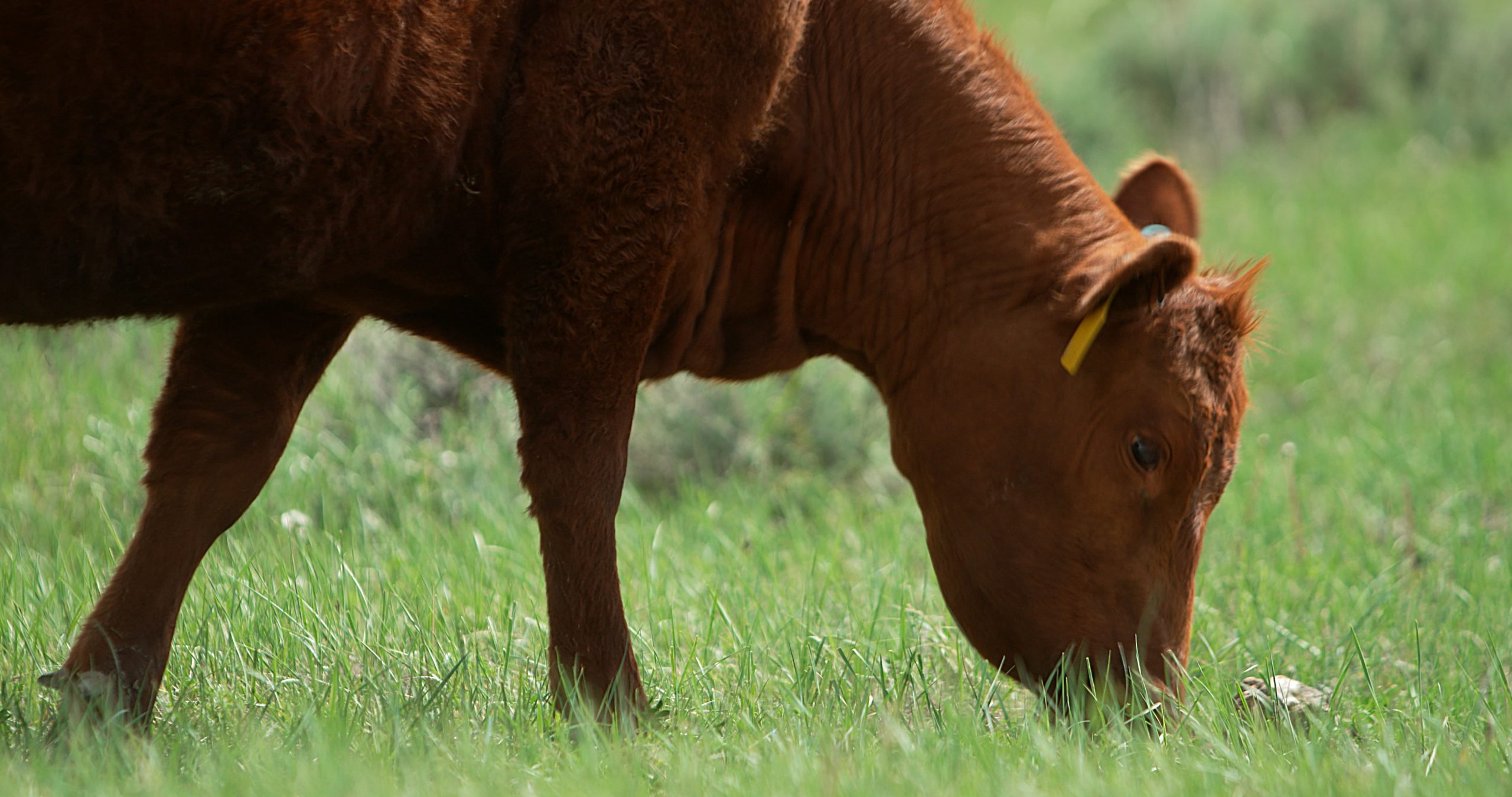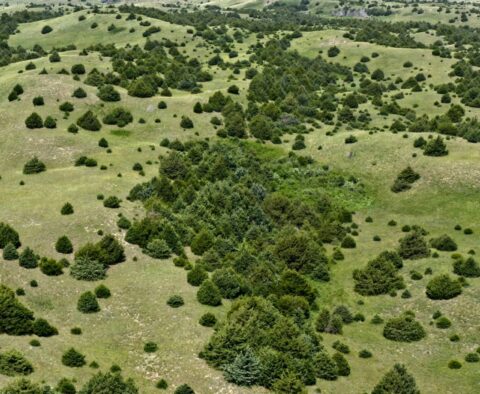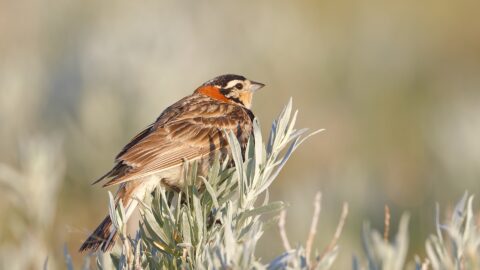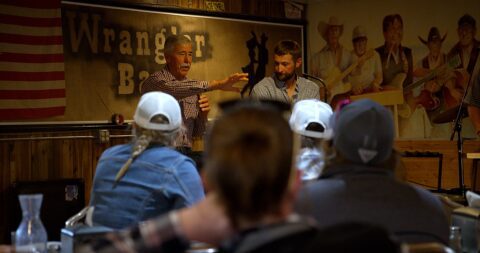“Mending Fences”
For Soil, Forage, and Wildlife
Reducing the impacts of widespread fencing on migratory wildlife while meeting ranchers’ needs in northeast Montana.

The changes that we’re making with our fencing, both in permanent fencing and in temporary fencing, are benefiting the wildlife. At the same time, it allows us to have better grazing management that results in better grass, which is what we want for our cattle.
Laura Nowlin, Winnett ACES
We’re putting the hitch on so that we can hook up this smooth wire. This is part of a wildlife friendly fence that we’re installing.
You’re gonna have to jam her in there a little further.
And the purpose of it is to make sure that the migrating wildlife, pronghorn, deer and things like that are protected when they try to go back and forth on the fence. Because with the barbed wire previously on the bottom and top, it can really tear up the animals pretty good.
Well, you’ve got your barbed wire here and we’re going with a smooth. So when the antelope go through it, they don’t get all cut up from this. If you see an antelope running through a six wire fence, it’s like they explode. Their hair just goes goes everywhere. It’s like, oh, you poor thing.
Just go really, really slow in case it gets hung up, you know?
There you go. We’ll have a smooth wire. So the antelope don’t get all tore up.
Saving the world.
Pronghorns. Sorry. Pronghorns.
This is the original US highway 2. So, the first highline that followed right next to the railroad tracks. You have a railroad track, a highway and two fences, all within like 100 yards. It’s just basically a triple whammy.
2011 was the year that we had 12 feet of snow. And it was almost routine to see reports of hundreds of animals being hit either on highways or railroads.
Fence maintenance. Fence construction and fence issues are probably the second largest use of ranch operating dollars and time. There’s really no way getting around how time consuming it is.
So at this location, do you have a set of three cameras here.
We got ten cameras spaced out, 30 meters apart.
The issue with this fence line compared to some of the more interior ones – we do pick up a lot of traffic as they interact and potentially cross the highway here.
Up in Alberta, A Pronghorn project was started back in their early 2000s. And overall, we recorded the longest distance migration for Pronghorn at 550 miles. And one of the things, as we were doing our observations and collecting data, is we saw that they were making these linear movements, and so we would go to these places and by and large they were fences. We have some instances where animals have to navigate up to 1000 fences a year.
You can really see well on here, the hair loss that’s occurring on the back.
We’ve had the traffic going by as we’re standing here now. So, you know, them antelope have trouble. So if the fence is tough and the traffic’s here – It herds them – to an uncomfortable situation for the antelope.
There’s so much fencing on the landscape. And we don’t understand from an ecological perspective, from a wildlife perspective, what the potential impacts are. One of the first things that we realized is that we don’t really know where fences are on the landscape. And so we started a discipline called Fence Ecology, where we really started to try and gain more and more information on how these linear features are potentially impacting wildlife and the integrity of ecosystems.
When you look at the map, it had habitat features on it. It had different fence structures. It had the GPS movements. The map gets busy over time, but when you tease out those layers, you can really find those pinch points and you find some areas where there’s no movement occurring and it’s because there’s barriers out there. It’s not that the habitat is not there, it’s just that they can’t get access to it.
We’ve used the science to move to on the ground implementation. We use the scientific approach to prioritize where to do fence modifications and removal because there’s not that much money to go around. So if we can do these things in the best spots, then that’s great for conservation and for the people out on the landscape in the wildlife.
If you had to take a guess how many miles of fencing does your ranch utilize?
I had to figure it out at one point or as close as I could just by looking at a map. And it’s around 98 miles of fence line on the ranch.
I can’t really say for sure, but I think it’s somewhere in the neighborhood of about 500 miles.
We have 15 miles of two wire electric fence on the ranch, as well as 60 miles of barbed wire that is anywhere from 80 years old to five.
On this ranch alone over 93 miles of fence. These bottom two wires, we figure it was left over from World War Two.
I couldn’t even guess how many miles of fence are on the ranch. It’s … I’m sure it’s hundreds. I mean, it just doesn’t seem like it would be that much. But, I mean, you start adding it up, and it’s a lot. This fence may be 100 years old.
Several years ago, when the Fish and Game started asking us if we could build our fences to wildlife friendly standards. They were talking about a bottom wire that they want 16 inches off the ground so that antelope conduct underneath it. And initially, I looked at those standards and I said, I’m not sure that’s really going to work for us, but this is a really old fence. It’s at 15 inches. So raising that an inch or two isn’t going to be a problem at all. It’s one of those things where you thought this was going to be an inconvenience or this just isn’t going to work to build it to wildlife friendly standards. But as it turns out – it works just fine.
They’re not going to come. They have new babies. So they they don’t want to have anything to do with me.
Typically back when you had a wire pretty low, there was a fairly wide spacing and the top wire was pretty tall. And it definitely doesn’t work in our area, we have a lot of elks. With the fence retrofit, what we did is we basically rebuilt the whole fence except for the the posts that were still solid. Then we changed the spacing. If the wires are too close together, deer that are trying to jump the fence can do this and then get tangled up.
A lot of these things can be cost prohibitive, especially in year like this one, when we’re in a drought, I, I wouldn’t even be building a new fence over north if … I mean, if it wasn’t for the people that are helping to fund the project. So it’s just … It’s paramount that we keep those partnerships going.
If you’re looking at 100 miles of fence and it’s, say it’s good for 20 years, you’re replacing a fifth of that every few years. So that’s a pile of funding to find. And I mean, you’re one of a few hundred ranches in this area. So for those programs to come together like that, that’s I think why having places where fence is a value for wildlife and ranching and people are willing to do things that have a wildlife benefit and a ranching benefit has been good for us to bring partnerships together.
Put a little Thousand Islands or French on it?.
We’ll start in with a cross fence on Akins Coulee with the two wire …
The changes that we’re making with our fencing, both in permanent fencing and in temporary fencing, are benefiting the wildlife. At the same time, it allows us to have better grazing management that results in better grass, which is what we want for our cattle.
To manage the grazing more efficiently. We want smaller pastures so that we can rotate through and concentrate on certain areas more.
We’re trying to use our grass for a shorter duration during the growing season.
Traditionally, it would be a three or a four wire fence. But the electric fence is just a fraction of the cost of a normal four wire fence.
It’s easier to put in. It’s easier to maintain. It doesn’t cost as much and the cows respect it.
I got it down to like 45 seconds to put one together, put a battery in it, and put these things on it.
Fencing, since it’s been used in the late 1800s, has been grazing technology. It was the technology that allowed management to happen at large scale across the western United States.
People my age don’t ask very many questions about this, but the next generation is going to need an opportunity to up their game. And I think a virtual fence could replace a lot of fence.
The chain attaches to each side. There’s an audible warning to warn the cows that she’s near the boundary. And then there’s a physical stimulant that will turn them when they hit the boundary. And it only takes them like one or two applications and they learn.
Is your whole her to have the?…
They do now.
We’re trying to lift the nutrition of the pastures, the rangelands, by taking at least one bite out of every piece of vegetation on the ranch and then giving it a long rest period. So that it regrows and then it starts to feed the soil biology. That’s why we’re dividing these pastures. We manage our cows for the benefit of rangeland and soil health. And if we do a good job, all these species can thrive. If we do a bad job, nobody gets anything.
Scups!
Well, this wasn’t the frickin plan,
Oh, man.
So now you got to get this put up righ?
Yeah, I’ll put it back up.
One of the beauties of temporary fencing and then just using one wire fencing to split these paddocks … Obviously, wildlife is hardly interrupted at all .. going through this stuff. And then when we’re done a lot of this temporary stuff, we just pull out.
Last year was the driest year in 120 years out here. The only other year dry was 1931 during the Dust Bowl. So …
The main idea with adaptive grazing is recovery time. So, overgrazing happens not because of the amount of animals, but how long they’re left on the land. So, we move quickly. It’s as many animals as possible for the shortest amount of time possible so that we could really stimulate that growth and help to germinate new forage and plants.
And then there hooves – the fact that they’re concentrated – are actually impacting the ground to make it more receptive for moisture, getting that litter on the ground so the microbes can work on it. So this is all about trying to improve our soil biology – using the cows.
Out here in the prairie, if you don’t graze something for a year and a half or two years then you’re just frickin waisting it. You know, I mean, the plants need that response.
So anyway, we’re trying to keep the landscape as open as possible, but using temporary fence to create all this flexibility of movement.
They’re just going to camp on this fresh feed and they’ll do really well. And then tomorrow we’ll be stripping them all the way across that flat over there.
Cows are on fresh feed. All’s good.
People are standing here thinking that what they’re seeing and hearing is actually rain, but it’s a delusion. It’s not.
I mean, I’ll get excited when the ground actually looks wet.
End of Transcript
To show in the film how fences impede wildlife movement, we combined a model of fences across the Hi-Line region with movement data from collared pronghorn.



